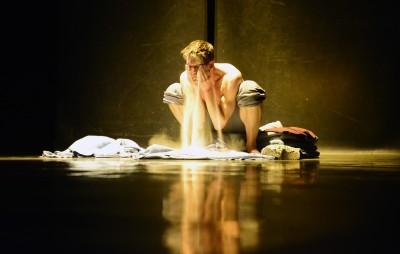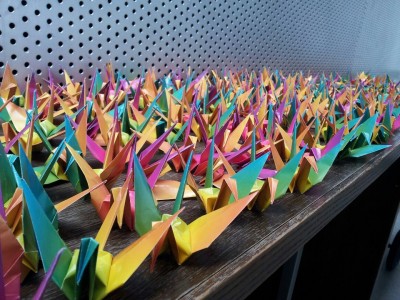 I’ve wanted to write about my continuing experiences of performing Cure but it’s been difficult to think about resuming those experiences in a coherent blog post when they feel like they are still unfolding on many different levels. I performed Cure at The Place as part of the Spring Loaded season and, unlike Tabernacle which we presented there in 2011, I felt that we’d managed to create or find a better context for the work in that theatre. I was very happy with the reception and with the engagement of the audience as evidenced in the post-show discussion, hosted by Luke Pell. ( I asked Luke to host the discussion as I trusted his ability to frame the work in a way that felt right. Of course asking him was a kind of curatorial framing of the event on my part.) I’ve also performed Cure at Firkin Crane as part of the Cork Midsummer Festival. While the Place stage is almost identical to Project Arts Centre, Firkin Crane’s is quite different, but I was ready to deal with the changes that will be necessary as we tour the piece and bring it to different locations. Cure feels like it has a sufficiently strong identity now to be able to cope with alteration and accommodation.
I’ve wanted to write about my continuing experiences of performing Cure but it’s been difficult to think about resuming those experiences in a coherent blog post when they feel like they are still unfolding on many different levels. I performed Cure at The Place as part of the Spring Loaded season and, unlike Tabernacle which we presented there in 2011, I felt that we’d managed to create or find a better context for the work in that theatre. I was very happy with the reception and with the engagement of the audience as evidenced in the post-show discussion, hosted by Luke Pell. ( I asked Luke to host the discussion as I trusted his ability to frame the work in a way that felt right. Of course asking him was a kind of curatorial framing of the event on my part.) I’ve also performed Cure at Firkin Crane as part of the Cork Midsummer Festival. While the Place stage is almost identical to Project Arts Centre, Firkin Crane’s is quite different, but I was ready to deal with the changes that will be necessary as we tour the piece and bring it to different locations. Cure feels like it has a sufficiently strong identity now to be able to cope with alteration and accommodation.
I’ve enjoyed each time getting on stage to perform Cure. It’s not a piece I enjoy rehearsing on my own and that is not surprising since it was never conceived as a solitary experience even though it’s a solo. It was made always with at least two in the room and even when I rehearsed in Dublin before the choreographers came, I always had Ciaran or Mags or Alma watching, always preparing me for the audience who are necessary to complete the experience of the work. For practical reasons now I have to rehearse the piece between tour dates on my own and it is difficult. Getting on stage reconnects me now with what I know to be the distinctiveness and identity of this piece.
The recent newsletter from Create features an essay by Grant Kester called Collaborative Art and the Limits of Criticism. In it Kester draws a distinction between ‘conventional art practice [where] the act of production is distinct and clearly separate from the subsequent reception of the work by viewers, during which the artist is typically
not present.’ and ‘dialogical art practices [where] production and reception co-occur, and reception itself is re-fashioned as a mode of production. As a result, the moment of reception is not hidden or unavailable to the artist, or the critic. Moreover, the experience of reception extends over time, through an exchange in which the responses of the collaborators result in subsequent transformations in the form of the work as initially presented.’ Though I’m not sure Grant would have Cure in mind when thinking about dialogical practice or collaborative art, I recognise in my experience of Cure the kind of dialogue to which he refers. Cure is a live performance. While the audience may not move about, their interaction with the work, – a kind of engaged viewership rather than passive consumption – is what makes and remakes it. That engagement extends over time, in the performance and beyond. The feedback of which I’m most proud is from people who say they couldn’t stop thinkiing about the piece or that the images stayed with them:
‘The images are still fixed in my head and I cannot and do not want to rid of them. ‘
Some who subsequently write about their experience of the work in their own blogs extend my experience of the work and reassure me that its ephemerality in the stage space is balanced by its ability to embed traces of itself in the thoughts and bodies of others. For Kester, ‘Conventional object-based practices are clearly finite; they exist for a fixed period time (the duration of an exhibition or commission, for example), and then end.’ While it might seem that a dance performance is similarly finite, in Cure, and in all my work, I want to focus on how, like the dialogical practices, that Kester favours, my work ‘can unfold over weeks, months and even years, and [its] spatial contours or boundaries typically fluctuate, expand and contract over time. As a result, this work confronts the critic with a very different set of questions. When does the work “begin” and when does it “end”?’ The work of Cure is more than a single performance. Cure is the itinerant and diverse process of its creation, it is the community who watched it evolve in the studio, in the experiences of those who saw it on stage so far, in the sharing of food and conversation that we facilitated as part of the Dublin Dance Festival and that I will continue in various forms when we tour in the Autumn, in the conversations with UCLH to do a workshop with patients and clinicians that in the end didn’t happen. Cure continues in my body and I am curious to see how it emerges again in performance when I return to it this Autumn.
‘Time, in the conventions of avant-garde artistic production, is always synchronic; new insight is transmitted to the viewer through a singular and a-temporal moment of shocked recognition. This model of reception assumes a viewer who is operating under the enforced thrall of an ideological system, which can only be broken by a countervailing moment of homeopathic violence. As a result, there is no understanding of receptive time beyond the moment of disruption itself. With dialogical art practices temporality is both extensive and irregular, marked by a series of incremental subdivisions within the larger, unfolding rhythm of a given work. As a result, it’s necessary to develop a system of diachronic analysis and notation that can encompass the project as a whole in it’s movement through moments of conflict and resolution, focusing on the productive tension between closure and disclosure, resistance and accommodation.’



Post a Comment